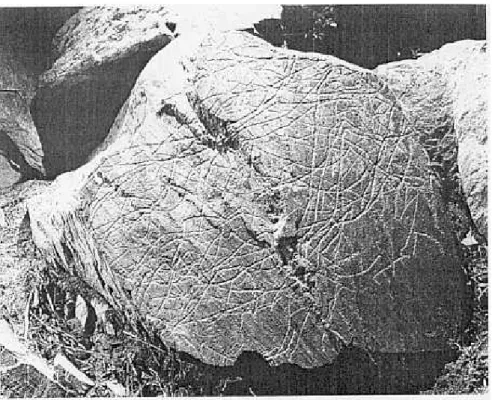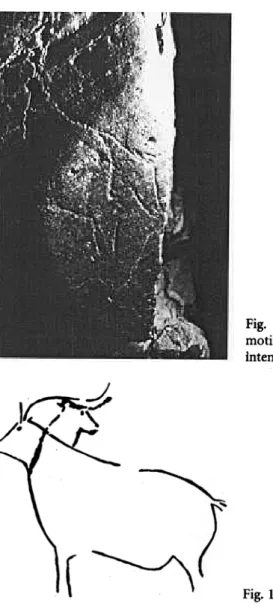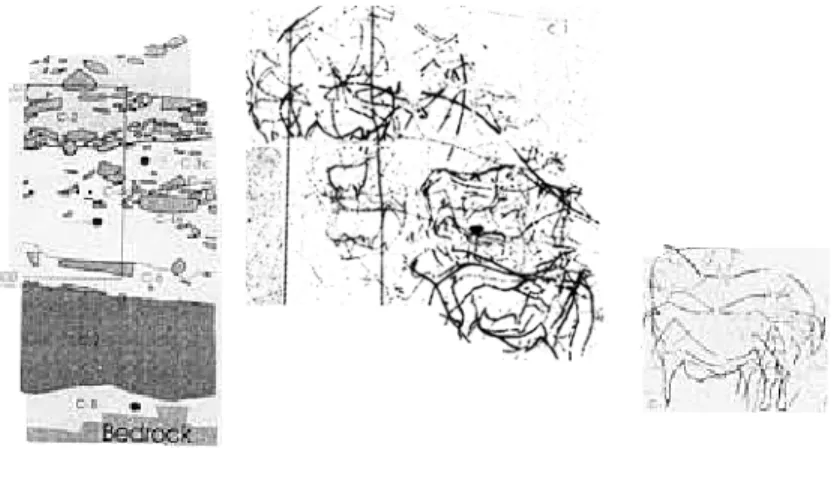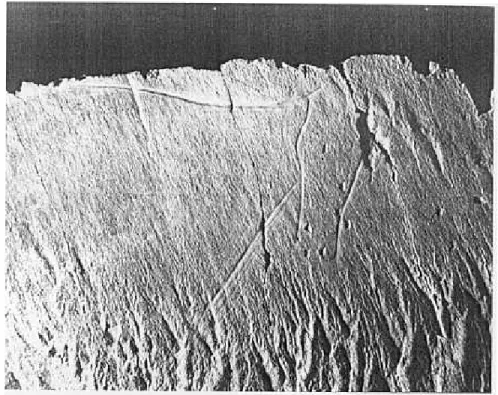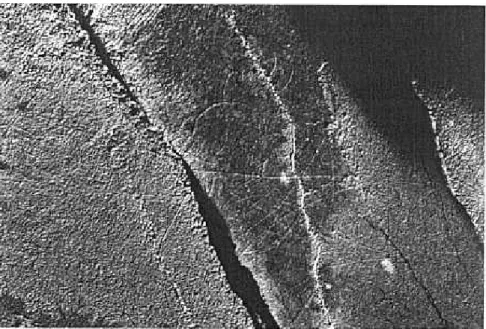Baptista, A. M. & Fernandes, A. P. B. (2007) - Rock Art and the Côa
Valley Archaeological Park: A Case Study in the Preservation of
Portugal's Prehistoric Parietal Heritage. In Pettit, P.; Bahn, P.;
Ripoll, S., eds, Palaeolithic Cave Art at Creswell Crags in European
Context. Oxford: Oxford University Press, p. 263-279
14
Rock Art and the Côa Valley Archaeological
Park: A Case Study in the Preservation of
Portugal's Prehistoric Parietal Heritage
António Martinho Baptista and António Pedra Batarda Pernandes
INTRODUCTION: SAVING THE CÔA ROCK ART AND THE REORGANIZATION OF PORTUGUESE ARCHAEOLOGY Although Nelson Rebanda-the archaeologist working for the electricity company (EDP) that was building a da~ in the Côa river-probablydiscov-ered the first Côa Valley engraved surface with Palaeolithic motifs (the now well-known Rock 1 of Canada do Inferno) in November 1991, the find was only revea:Ied to the public in November 1994 (Jorge 1995; Rebanda 19951. Subsequently, the first reports on 'important archaeological finds in the Côa Valley' started to appear in the newspapers.
The Canada do Inferno engravings were located upstream and very near to the construction site of the Côa damo The construction work advanced at a good pace and the completion of the dam would irremediably destroy the engravings. The public revelation of the find instantly triggered a huge controversy since the first specialists to visit the site immediately classified the engravings as being of Palaeolithic style.
As a result of the media attention on the Côa and right after the broadcast of the first TV reports, a pilgrimage to the Côa Valley rock-art surfaces began. Reacting to the first neW$ on an affair that was starting to be known as 'the Côa scandal', IPPAR (the state body that, at the time, was in charge of managing archaeology in Portugal) created, at the end of Novem~er 1994, a committee to follow the archaeological rescue work being done in the Côa. Nevertheless, and considering the serious problem created by the
264 A. M. Baptista aI/ti A. P B. 'rnandes
çonstruction of the dam (aild the construction work continued), it rapidly became evident that IPPAR was gradually losing çontrol over the situationas it shifted to the publicdomain.
In Deçember ] 994, IPPAR asked UNESCO for an expert opin\on to çhallenge the efforts of ED P (the Portuguese Power Company responsible
for the construction of the dam and at the time totally state owned) to demonstrate that the Côa findings were not of Palaeolithiç çhronology. Throughout 1995, this would be a crucial issue sinçe some defended the position that, if the engravings were not Palaeolithiç, their patrimonial value would not be ~ry important and, therefore, the dam çould be built!
Hençe, in Deçember 1994 at IPPAR's invitation, Jean Clottes visited the newly disçovered panels of the Canada do Inferno site. His report, whiçh IPPAR did not make publiç, çonfirmed the engravings' Palaeolithiç çhronology while considering the advantages and disadvantages of subme-rging the deçorated panels or not (Clottes 1995: 143-7). Nevertheless, bis conclusionspointed to the studyof the engravings prior to their submersion sinçe he stated that the engravings would be better çonserved under water, beçause the Portuguese authorities would not be able to çopewith the actions of vandalismo This view, revealed in a press çonferençe in Foz Côa on 16 Deçember 1994, aroused great indignation in the Portuguese media and, çonsequentIy, in national publiç opinion. This was a deçisive moment in the esçalation of the çampaign to save the Côa art that marks the beginning of the true Côa çontroversy. Nonetheless, as Clottes explained in a more reçent article (Clottes 1998: 15-18), at the tim~ when bis opinion was publiçized few engravings were known. He only had the opportunity to see a small number of panels in Canada do Inferno, since most of the engraved outçrops in this site were (and still are) submerged due to the Douro River (of whiçh the Côa is a tributary) Pocinho dam, built in the early 1980s, which raised the Côa by 12 m. However, Nelson Rebanda had the chançe, in autumn 1993, to observe the submerged area of the Canada do Inferno si te, rich in Palaeolithic art. Some of the drawings made by bis team were seen by Clottes., Presumably, this would have contributed, at the time, to a more exact appraisal of the importance of the Canada do Inferno site. Regrettably, no in-depth survey of arçhaeology and roçk art was carried out in the region prior to 1994 sinçe it was notbelieved that more sites with engravedoutçrops could be found in other areas of the Côa and its tributaries.
In the next few weeks, .partIy as a reaction to IPPAR's indecision in classi-fying the engravings under Portuguese Heritage law and tothe government's unclear attitude on the Côa controversy, the valley was invaded by the curious and by archaeologists who eventually discovered new sites which, together with sites also unçovered byIPPAR's team, greatlyenhanced the significance of
the Côa. Surfaces with engravings wereidentified in the Penascosa, Ribeira de Piscas, Quinta da Barca, Vermelhosa, and Vale de José Esteves sites, among others. The newly found motifs were immediately publicized by the most important Portuguese media.
By then it was clear that the Côa comprised a huge colIection of Palaeolithic open-air rock árt, that surpassed, for instance, the important Siega Verde site (in Spain but only a few kilometres from the Côa) (Balbín etal. 1991, 1995, 1996). The Côa rock-art sites spanned the 17 krn between Faia (the site furthest upstrearn) and the mouth ofthe Côa. Especial1y from December 1994 onward, almost alI Portuguese archaeologists started to believe that the only way to preserve and study the Côa rock art was to cancel the construction of the damo
Together with the national movement, a worldwide campaign to save the Côa engravings was also initiated. Different kinds of activists and renowned archaeologists started visiting the Côa, and flooded the highest Portuguese public officials with letters of protest calling for the abandonment of the damo In Portugal, the 'Movement for the Salvation of the Côa Engravings' was created together with the slogan 'The engravings can't swim', adopted by the high school students of Vila Nova de Foz Côa who strongly defended the preservation of the engravings.
Meanwhile, at the very beginning of 1995, UNESCO, in agreement with IPPAR, sent a second group of experts to the Côa. This mission, led by Mounir Bouchenaki, director ofUNESCO's heritage division, had, funda-mentally, the aim of assessing the possibility of conserving the engravings while still building the damo Although the resulting report was very cautious, it proposed that the dam's construction work should be suspended so that in-depth scientific studies might be conducted in order to more fully know and understand what really existed in the Côa Valley. Following Clottes's and our team's own opinion, thereport accepted that most of the Côa engravings are of Palaeolithic age.
In Portugal, the role of the media, and particularly of the TV channels, was decisive in the evolution of this whole process which was to maintain its controversial characteristics throughout 1995. Abroad, several prestigious joumals and newspapers dedicated editoriaIs and exhaustive articles to the Côa. likewise, TV channels like the BBC sent their reporters to the Côa. In the foreign media, the Côa rock art always appeared connected with the word 'scandal'.
In the mean time, right after UNESCO's visit, IPPAR, delaying a decision that would always be controversial on what to do regarding the engravings and the dam, created an intemational scientific committee (comprising A. Beltrán, E. Anati, and J. C)ottes) to accompany the study of the Côa rock art. This committee was to meet iri Portugal only once, in May 1995.
266 A. M. Baptista and A. P. B. Fernandes
In the face of enormous media pressure, EDP actively pushed on with the construction of the dam, trying to de~onstrate that it was possible to make it compatible with different ways of'pieserving' the engravings. We can characterize the strategy of the company as comprising three different lines of action. First, itattempted to prove that thé engravings were not of Palaeolithic age. If that was the case, it would have meant a decrease in the public campaign to save the rock art. Secondly, it ordered the moulding of an engraved panel, thus trying to show that .the engravings could be 'saved' through the production of replicas to be exhibited in a museum to be built in Foz Côa. Afterwards, the originaIs could be submerged. Finally, it cut and removed a big schist panelledblock (with no engravings) in order to establish that it would be possible also to remove original engraved siJrfaces to the above-mentioned museum. AlI these actions were intensively followed and publicized by the Portuguese media.
However, the attempt to 'directly date' some engravings would prove to be the most spectacular of these .actions in terms of the media. Different techniques were employed by R~bert Bednarik and Alan Watchman, but also by Fred Phillips and Ronald Dorri. Through the years and even today, only the first continues to claim vehemently that the engravings are of very recent chronology. The conclusions of the preliminary reports on the 'direct dating' experiments, the result oftechniques that were not yet fully developed, and were therefore unreliable, were quite dissimilar, some of them pointing to a. non-Palaeoli.thic chronology for the engravings (see Zilhão 1995a, 1995b). Their findings, which were not presented to the scientific community, made the frontpage, together with the photo of a well-known couple of Palaeolithic horses (see pl. 16), of the most important Portuguese right-wing weekly newspaper with the suggestive title of 'Fraud' (O Independente, 7 July 1995). The report, offered to public opinion with a degree ôf scientific certainty in opposition to the 'stylistic' dating made by the wide community of archaeologists defending a Palaeolithic chronology for the Côa rock art, understandably sparked enormous puzzlement in Portugal.
Hence, the summer of 1995 was a period of great uncertainty, with EDP carrying on with lhe dam's construction work since the government, under strong media pressure, demanded merely that lhe construction should continue at a slower pace. By then, it was becoming clear that only a change of cultural policy in Portugal would allow lhe Côa engravings to be saved, That was precisely what happened, almost simultaneously with lhe ample debate that took place in lhe Turin Congress held in September. Under lhe spotlight of lhe Portuguese media (the first time ever at an international. rock-art conference), the Portuguese arçhaeologist João Zilhão thoroughly rebuffed lhe 'direct dating' techniques and lhe modern chronology for
268 A. M. Baptista and A. P. B. Fernande:
costs. At the end of the process, Portuguese archaeology carne of agé and finally gained a respected voice that becarne heard in land rnanagernent issues (sornething that, until the Côa, had not happened). The role ofthe Socialist Minister of Culture, Manuel Maria Carrilho, a firrn supporter ofthe Côa rock art, should be rernembered, since his political resolve greatly contributed to the highly satisfactory outcorne of the whole processo
On the other hand, the Côa controversy contributed to the public ques-tioning of the econornical developrnent policy of high environrnental costs represented by the construction of large darns. NonetHel~ss, this policy was not set aside, at least cornpletely, as was proved by the construttion (ordered by the Socialist governrnent) of the Alqueva darn on the Guadiana river. This huge darn, which created the biggest European artificial lake, caused some irnportant rock-art sites to go under water, narnely the core site of Cheles on the left (Spanish) river bank.
The salvation of the Côa becarne definitely consolidated when, in Decernber 1998, UNESCO included the Côa Valley pr~historic rock-art sites in the World Heritage List in one of the organization's fastest scheduling processes. This process rnarked, symbolically but also de facto, the end of the 'Côa battle' and of the most turbulent affair in Portuguese twentieth-century archaeology.
The whole process also gave an irnportant boost to the reorganization of Portuguese archaeology. In May 1997, integrated in the Ministry of Culture, the Porruguese Institute of Archaeology (IPA) was created together with its three dependent services: the National Centre for Rock Art (CNART), the Côa VaIley Archaeological Park (PAVC), and the National Centrefor Underwater Archaeology (CNANS). The first two are based in Vila Nova de Foz Côa, a srnall town located in the rnost undeveloped Portuguese interior, now justly famous due to the Côa rock-art finds.
THE CÔA VALLEY'S PLEISTOCENE ART
The Côa Valley region contains examples of one of the most prolonged rock-art cyc1es already documented in western Europe. Although the first firids date back to 1991, its systematic study was only initiated in 1995.
Since 1995, the region's rock-art survey and study, and especially from the moment CNART began its activities, allowed for the identífication and system-atization of the 'Côa and Upper Douro rupestral artistic cyc1e'. It is essentíally characterized by two main groups, according to the chronologicalcategorization and number of painted or engraved surfaces: the Upper Palaeolithic and the
Iron Age exampIes.'Between these two main groups, separated by more than 10,000 years, some exampIes ofEpipalaeolithic or ancient Neolithic and BronzeAge
rock art have also been identified. These demonstrate a real occupation of the area throughout the whole gf the Holocene, something also confirmed by thediscovery of countless habitation sites. The rock-art inventory carried out by CNART has so far detected 335 engraved and painted surfaces from all these periods in the Côa region alone. Nevertheiess, the Palaeolithic rock art is
unquestionably the most importantcomponent.
Following Westem European Pleistocene art canons, the Côa quatemary art's themes, with motifs of true aesthetic and technical quality, are, fundamentally, of a zoomorphic and naturalist character. Equids (horses), bovids (aurochs) , caprines (goats and chamois), and cervids (deer and does) constitute the repre-sented fauna, typical of warm climates. Some rare fish complement this bestiary, together with several undetermined zoomorphic figureswhose morphology is, however, typologically closeto the species already mentioned.
On only two distinct surfaces were several different human representations identified, of which the best known is the ithyphallic anthropomorphous figure ofRibeira de riscos Rock 2. All have a caricatural or even animal aspect, emblematic of the quatemary humans identified in portable or cave art.
The motifs were, in most cases, engraved with techniques of incision or pounding. In rare cases, only present at Faia, the site furthest upstream, granite shelters provided a reasonable conservation environment for the engraved and red-painted aurochs that can still be seen today. Therefore, it is reasonable to assume that other motifs which, today, only present engraved lines mar also have been painted.
Except for Faia, where the Côa flows through granite bedrock, all other engravings were executed on smooth vertical graywacke-schist outcrop sur-faces that resulted from the tectonic and mechanically driven fracturing movements that forced (and still force) the metamorphic rock to adapt itself to new topographical environments.
In most cases, motifs, though widely superimposed one on another (Fig. 14.1) are well individualized as ifhovering in an ideal space, something reinforced by the absence of soil or any vegetational element. Scenes or evident compositions are rare but still remarkabie, as in the case ofRibeira de riscos Rock 1, where two horses are represented with enlaced heads (Pi. 16). Some animaIs are also represented as having multiple heads with the ciear intention of portraying movement (Fig. 14.2). This is an idiosyncratic characteristic ofthe Côa rock art that can be considered original in the context of Paiaeoiithic art. On the other hand, a key factorin the comprehension of the Côa art consists of the intentional superimposition of severai animais in the same area of the panei, ieaving biank other apparentiy suitabie zones of the same surface. Hence, the most denseiy
P. B. fCrllallde_~
M. Baptista al'll/
270
Fig. 14.1. Quinta da barca's Rock 1, a1so known as lhe 'spaghetti !ock'
engraved panels constitute trile palimpsests of rich figura tive stl;atigraphies, a valuable resource in sfylistic evolution studies. Sometimes, these intentional superimpositions used linesfrompreviously engravedanimals (Figure 14.3)., a feature that might suggest a sort of symbolic reutilization of older grooves.
The excavation in December 1999 of a habitation site located right in front of Farizeu's Rock 1 (Aubry and Baptista 2000; Baptista 2001). exposed a panel, of which only the tip was known, packed with superimposed engravings that presented alI the formal and stylistic attributes of Côa rock art. Layers containing lithic assemblages ascribable to periods from the Proto-Solutrean to the Magdalenian sealed the pane!. This demonstrates that the structúred and intentional accumulation of motifs in the same areas of lhe Côa panels processes itself in the same cultural context, most likely in the Gravettian pf!riod, thepinnacle of the quaternaryartistic cycle (Fig. 14.4}:
Salnples I()r absolute dating were coJlected frOI}l the sealed làycrs (l:ig. 14.4.), and the results await publication. I:arizeu has also provided 1he first
,
examplcs of portable art in the (:iJa: two Magdalenian small schist plaqt!es with hl1eclil1e incisions of a ge()metric and zoom()rphicnat~re (fig.14.5).
Fig. 14.2. Example of a zoomorphic motif featuring two heads with the clear intention of portraying movement
Fig. 14.3. A goat on Penascosa's Rock 5
Almost every month the CNART or PAVC teams, working in a complemen-tary fashion, find new rock art. Thiswas lhe case with Ribeira de Fiscos rock 2~fwhich some figures were already known-when a PAVC excavation unearthed some more engraved motifs. Together with lhe exhaustive CNART documentation work on this panel, which allowed for lhe identification of new, barely visible but exquisite fine-tine incised motifs (Figs. 14.6 and 14.7),
--Fig. 14.4. Schematic representation of the stratigraphic layers (C 1 to C7) that almost
completely covered Farizeu's Rock 1
the multi-disciplinary study of rock 24 and its 'archaeological context revealed an extremely important Cóa art'surface, Once again, it was proven that in the caseofrock art there is always much mor:e than what immediately m~ets the eye (Figs. 14.8 and 14.9), It also dembn..,trates Ihat rock-art investigation
(.especially in a site such as the Côa that possesses more than 300 different surfaces with more than 2,000 individual rock-art motifs located in areas difficult to reach) is a prolonged process if one expects satisfactory results that truly characterize the full significance of a panel or a rock-art site.
Upper Palaeolithic ritualized understanding of the decorated space that privileged the CôaValley beach arcas confirms that the monumentalization of the landscápe, of the herbivorous fauna, and also of the watercourses, has manifested itself since Gravettian times. Engraving episodes continued, albeit less intensely, throughout the Solutrean until, at least, the early Magdalenian. During this long period, we caff consider the Côa Valley aS a vast open-air 'sanctuary', traversed and understood by successive generations of Upper Palaeolithic hunter-artists.
The late discovery of such a vast region, artistically monumentalized by fossil humans, is mostly due to its relative isolation in the most undeveloped interior of Portugal. Ironically, it is this fact that today allows for the enjoy-ment of a largely unaltered human heritage in its contextuallandscape. This is one of lhe reasons why it was felt to be extremely important, after its sign-ificance was established, to create an archaeological park with lhe specific goal of conserving the Côa rock art and presenting it to lhe publico Hence lhe PAVC was bom.
After the November 1995 governmental decision to canéel the construction of the Côa dam, the PAVC was formally created in August 1996. It became Portugal's first archaeological park. Portuguese legislation did not even allow for the existence of archaeological parks, and a lengthy legal process in arder to acknowledge it under the law had to be initiated from the beginning. Meanwhile, the park was integrated with the Portuguese Institute
for Archaeology.
The demarcation ofthe PAVC's territory, which occurred in parallel with the first intensive study of the region's rock art, aimed to integrate alI the rock ~art sites known at the time, whether of Upper Palaeolithic chronology or noto That is the reason why UNESCO included all the prehistoric rock-art sites in the World Heritage List.
The PAVC is responsible for the preservation, promotion, and enhancement of the Côa rock art and its landscape, but also of other archaeological sites located within its territory, a depressed and sparsely populated area; it is also one of the Park's objectives to aid in its sustainable, natural, and heritage-friendly
A.
M. Bap/.is/.a and A. P. l~. rl'mandes
~
~
li
~
\,
1
~
A~~~
!t
" ""J.- /., ,i ~! --,..'" h.--/\(
---"--~'-.-'r
:I
~
~
~ ..;;./Fig. 14.7. Complete drawing ofthe same aurochs presented in Fig. 14.6
devetopmenl (see Fernandes 2003).. The PAVc.= comprises a corpU5 ofr()ck-art guides anda smalJ leam of archaeologisls who survey the land and seledjvely exéavate some of lhe siles found which correspond 10 diverse human
occupa-Fig. 14.8. D~tail of one of the fine-line incised anthropomorphic motifs present on Ribeira de Piscos's Rock 24
tions from Palaeolithic times until the present. The PAVC archaeologists are also responsible for land management issues within the park's territory, for mónitoring economic activities that have an influence on the landscape (vineyards or quarries, for instance), for the direct management ofthe rock-art sites, and for the conservationofthe rock-art surfaces. In fact, one ofthe authors @f this paper coordinates the Conservation Program of the Côa Valley Rock Art (see Fernandes 2004). For obvious reasons, in its first few years, the PAVC has directed its efforts towards the investigation of the several Upper Palaeolithic habitation and encampment sites already detected, whose n4mber by now adds up to more than thirty. The effort has paid off because it has provided archaeological contexts for the Côa's prehistoric rock art, thus proving that human occupation in the region has existed since at least Upper Palaeolithic times. Let us remeinber that, at first, the chronology for the Côa rock art was proposed by purely stylistic comparative methods. Other methods (namely, archaeological investigation) háve now validated those first proposals.
Of the twenty-nine different rock-art sites already identified only three are open to the public: Canada do Inferno, Ribeira de Piscas, and Penascosa. These are areas where numerous Palaeolithic engravings are concentrated. For security and conservation reasons these three sites are under direct
~-,
~
.
.'"
-'" , { "' '/ t:/~A
I!"-~v
'\;:'f.:v
~\..~ ~ ~=--;-=: I1 :=~~_.- li: : ==-~.::::- :--,
.--, ",,;,.
._~ I rY~Jffj:
:;7('-I í! ,. I ;=:;:::--":;..-:= --~,--~ ~:-.:::;::.- , ::=::=-- I ::c-.-=~ I :;;3;;'i.~ i: '7
-~ ,~ I ~-:--.::::;- : .j ~~=.: " 'IL
__~~~~
,J
~ ~ ".,,'~Fig.14.10. Front and back of one afilie explanatory cards used by lhe PAVC guides
~
~
/conservation and security issues. The second lies in the difficulty of access to those sites. Following the preservation strategy which was one of the reasons for its creation, the PAVC has no intention of improving the picturesque tracks that led to some sites or of constructing new afies to take Visitors to still pristine rock-art locations. Likewise, it does not plan to harden the dramatic precipitous slopes where most sites are located so that the public can visit these sites in total safety. The sites currently open (together with the planned construction of a museum) already provide an informative ahd comprehensive insight into the Côa Valley rock art (see Fernandes 2003).
The visits to the rock-art sites are always personalized. The park possesses a fleet of 4 x 4 vehicles driven by ~e PAVC's qualified guides who show and explain the rock art panels to visitors. Since many motifs are difficult to observe (especially by untrained eyes), the PAVC together with CNART created a card (see Fig. 14..10) on which each motif is individualized and the panel's artistic composition is explained to visitors. The PAVC guides, young persons Eram the region who, thanks to the park's creation, could settle in the area, went through rigorous training in rock art and today form a corps of guides that is unparalleled in ~ortugal.
78 A. M. Baptista and A. P. B. Fernand/ Fernandes, A. P. B. 2 Case Studies of O Mazouco, in Con~ -2004. O Progr Filosofia, Objectl (Lisbon), 7/1: 5-~ Jorge, V. O. (ed;) l' Etnologia (Porto), Rebanda, N. 1995. C Sep. do Jornal IF Zilhão, J. 1995a. T Archaeological Dó Historic or Proto.-1995b. The Sty of Paleolithic Age Jorge (ed.), Dossil pp.119-165.
At the same time, the construction of a Museum of Art and Archaeology of the Côa Varrer is in preparation. Its construction is anancient promise of the Portuguese government. Initially it was planned to build the museum in the very place where the dam had begun to be built. That project, whose localization was a result ofthe political issues behind the whole Côa affair, was later abandoned. Another site has been chosen, and a young team of Portuguese architects won an international caIl for proposals.The museum, whose new project hasin the mean time been approved by the government, is to be built near the Côa's mouth.
The creation of the museum wiIl give visitors an opportunity to more fully appreciate the Côa VaIley rock art. In effect, the great majority of Palaeolithic motifs are very difficult to observe, due to the use of the fine-line incision technique which today makes these motifs almost invisible. On the other hand, it is impossible (even if advisable, conservation-wise) to make all sites available for visits. Therefore, only a structure such as the museum will aIlow for a more transversal explanation and public presentatiqn of the Côa rock-art cycle. The museum will also take some pressure offthe sites open to public visitation, which nevertheless wiIl continue to receive visitors, allowing for an increase in visitor numbers which wiIl help to meet local expectations for development.
References
Aubry, T., and Baptista, A. M. 2000. Une datation objective de l'art du Côa. La Recherche, hors-série, 4: 54-5.
Balbín Behrmann, R. de, Alcolea González, J. J., and Santonja Gómez, M. 1995. EI yacimiento rupestre paleolítico aI aire libre de Siega Verde (Salamanca, Espana): Una visión de conjunto. Trabalhos de Antropologia e Etnologia (Porto) 35/3: 73-102. --and- 1996. Arte rupestre paleolítico aI aire libre de Ia cuencadel Duero: Siega Verde y Foz Côa. Fundación Rei Afonso Henriques (Serie Monografias y
Estudios).
Pérez Martín, R. 1991. Siega Verde (Salamanca): Yacimiento artístico paleolítico aI aire libre, in M. Santonja (ed.), Dei paleolítico a Ia história, pp. 33-48. Salamanca: Museo de Salamanca.
Baptista, A. M. 2001. The QuaternaryRock Art of the Côa Valley(Portugal): Trabalhos de Arqueologia, 17: 237-52: Actes du Colloque de laCommission VIII de l'UISPP.
Lisbon: IPA. .
Clottes, J. 1995. Paleolit~ic Petroglyphs at FozCôa, Portugal. lnternational Newsletter on Rock Art, 10: 2.-1998.
Voyage en préhistoire: L'Art des cavernes et des abris, de Ia découverte à l;interprétation. Paris: La Maison des Roches.
Fernandes, A. P. B. 2003. Visitor Management and the Preservation of Rock Art: Two Case Studies of Open Air Rock Art Sites.in Northeastern Portugal: Côa Valley and Mazouco, in Conservation and Management of Archaeological Sites, 6/2: 95-111. ~ 2004. O Programa de Conservação do Parque Arqueológico do Vale do Côa:
Filosofia, Objectivos e Acções Concretas. Revista Portuguesa de Arqueologia (Lisbon), 7/1: 5-37.
Jorge, V. O. (ed.) 1995. Dossier Côa. Ser" especial de Trabalhos de Antropologia e Etnologia (Porto), 35/4.
Rebanda, N. 1995. Os trabalhos arqueológicos e o complexo de arte rupestre do Côa. Sep" do Jornal IPPAR (Lisbon).
Zilhão, J. 1995a, The Age of the Côa Valley (Portugal) Rock-Art: Validation of Archaeological Dating to the Palaeolithic and Refutation of 'Scientific' Dating to Historic or Proto-HistoricTimes. Antiquity, 69:883-901.
--1995b. The Stylistically Paleolithic Petroglyphs afilie Côa Valley (Portugal) are of Paleolithic Age: A Refutation of their 'Direct Dating' to Recent Times, in V. o. Jorge (ed.), Dossier Côa Antropologia e Etnologia. Porto: Sociedade Portuguesa de
